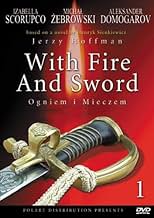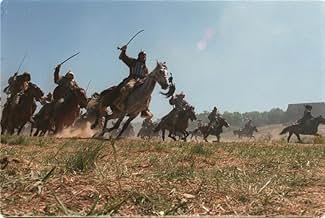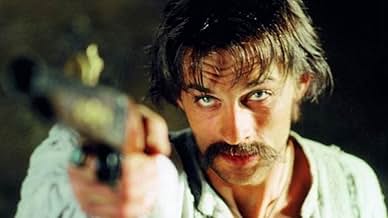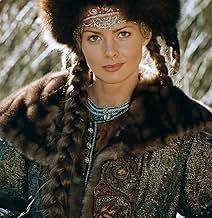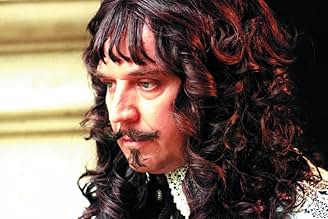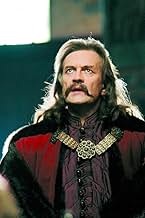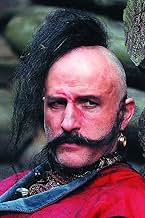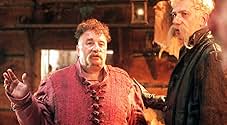Ogniem i mieczem
- 1999
- 2h 55min
VALUTAZIONE IMDb
7,0/10
5773
LA TUA VALUTAZIONE
Aggiungi una trama nella tua linguaAn epic story about the Ukrainian uprising against the Polish-Lithuanian Commonwealth magnates in the 17th Century.An epic story about the Ukrainian uprising against the Polish-Lithuanian Commonwealth magnates in the 17th Century.An epic story about the Ukrainian uprising against the Polish-Lithuanian Commonwealth magnates in the 17th Century.
- Regia
- Sceneggiatura
- Star
- Premi
- 5 vittorie e 9 candidature totali
Jacek Rozenek
- Jurko Bohun
- (voce)
Bogdan Stupka
- Bohdan Chmielnicki
- (as Bohdan S. Stupka)
Ruslana Pisanka
- Horpyna
- (as Ruslana Pysanka)
Recensioni in evidenza
Many comments have been made on the movie, the plot and the acting. I saw the movie at a private screening in Warsaw and loved it. Some of the scenes were well done, some great.
But the music....the music never leaves you. The variations on "Falcons" through the second half of the movie were wonderful. The scene on the river with the male chorus was haunting. THe music should have attracted more note than it did. But, not released in English, based on a super-nationalistic plot of dubious historic value, the movie was only going to appeal to a Polish audience, which it certainly did.
(For those who have commented on its excessive pro-Polish stance, they would be surprised to hear that, in Poland, the criticism was that it was too nice to Chmielnicki. Some said that Hoffman's Ukrainian wife had too much influence.)
The music is the lasting star of the movie. I have the CD and treasure it.
But the music....the music never leaves you. The variations on "Falcons" through the second half of the movie were wonderful. The scene on the river with the male chorus was haunting. THe music should have attracted more note than it did. But, not released in English, based on a super-nationalistic plot of dubious historic value, the movie was only going to appeal to a Polish audience, which it certainly did.
(For those who have commented on its excessive pro-Polish stance, they would be surprised to hear that, in Poland, the criticism was that it was too nice to Chmielnicki. Some said that Hoffman's Ukrainian wife had too much influence.)
The music is the lasting star of the movie. I have the CD and treasure it.
It seems to me that all means of expression are guite justified in this movie. It forced me to read the whole source trilogy (Ogniem i mieczem, Potop, Pan Wolodyjowski) by Henryk Sienkiewicz. Characters are very humaly, realistic and true. Battles are very naturalistic.
Mostly for Polish viewers, some basic knowledge of 17th century Poland may be helpful if you want to understand the movie. It's about the rebellion of Ukrainian Cossacks against their lords - Polish nobility (it was before tsars conquered Ukraine). Polish prince Jeremi Wisniowiecki fights them with extreme atrocity but when they ally with Tatars, is forced to withdraw to the fortress of Zbaraz. These events form a background for the love between one of Polish commanders and girl he meets while carrying out some emissary mission for the prince. The movie is based on the novel "With Fire and Sword" (orig. "Ogniem i mieczem") by Henryk Sienkiewicz (Nobel award for "Quo Vadis"). This book is the first part of a trilogy, other parts have also been filmed. I think it's important to read the novel and see all mentioned movies - "The Deluge" (orig. "Potop") and "Pan Michael" (orig. "Pan Wolodyjowski").
As a movie based on a book that is a staple of Polish reading, it is bound to attract its adherents and detractors. But overall it has enough merit to it to warrant at least a single viewing.
The story is set in the 17th century, during a period of strife on the eastern fringes of Polish territory, in today's Ukraine. The main plot centers around a rebellion of Cossacks against the oppression of Polish landowners, in the greater setting of a conflict between Poland, Muscovy and the Tartars.The book was written from a Polish standpoint, so there is some obvious favoritism shown, but the main characters are not one dimensional. The motivations of the characters are clearly explained, and the good guy is not always good, and the bad guy is not always bad. The political intricacies may be a bit confusing, but at its heart this movie is a love triangle, so as long as you focus on that, you can follow along.
The main reason to watch this movie is visual. If you are one of those people who likes to have a movie transport them to another time and place, this movie is for you. The costumes, props and scenery are simply beautiful. All the characters speak in the language they are supposed to speak, so you have conversations in Polish, Ukranian and even Tartar. The performances by the main characters are wonderful, ranging from comedy to romance to drama to action.
The movie has a bit of something for everyone. If you like action, the battle sequences are fantastic, very massive in scale. If you like romance, the lead characters are not too hard on the eyes, and their passionate feelings come across the screen quite strongly. There is a very strong comedy element as well, but you might have to understand Polish to appreciate it fully.
The special effects in this movie leave a bit to be desired. It certainly is a bloody, and at times gory film, but really no worse than a lot of recent US offerings.
If I was to use a US movie as a thematic comparison, Last of the Mohicans might be a good choice, with the hero looking for his love in a wild and savage environment.
Overall I would recommend this movie to fans of historical films. The plot is fairly straightforward, so you can focus on watching the visuals instead.
The story is set in the 17th century, during a period of strife on the eastern fringes of Polish territory, in today's Ukraine. The main plot centers around a rebellion of Cossacks against the oppression of Polish landowners, in the greater setting of a conflict between Poland, Muscovy and the Tartars.The book was written from a Polish standpoint, so there is some obvious favoritism shown, but the main characters are not one dimensional. The motivations of the characters are clearly explained, and the good guy is not always good, and the bad guy is not always bad. The political intricacies may be a bit confusing, but at its heart this movie is a love triangle, so as long as you focus on that, you can follow along.
The main reason to watch this movie is visual. If you are one of those people who likes to have a movie transport them to another time and place, this movie is for you. The costumes, props and scenery are simply beautiful. All the characters speak in the language they are supposed to speak, so you have conversations in Polish, Ukranian and even Tartar. The performances by the main characters are wonderful, ranging from comedy to romance to drama to action.
The movie has a bit of something for everyone. If you like action, the battle sequences are fantastic, very massive in scale. If you like romance, the lead characters are not too hard on the eyes, and their passionate feelings come across the screen quite strongly. There is a very strong comedy element as well, but you might have to understand Polish to appreciate it fully.
The special effects in this movie leave a bit to be desired. It certainly is a bloody, and at times gory film, but really no worse than a lot of recent US offerings.
If I was to use a US movie as a thematic comparison, Last of the Mohicans might be a good choice, with the hero looking for his love in a wild and savage environment.
Overall I would recommend this movie to fans of historical films. The plot is fairly straightforward, so you can focus on watching the visuals instead.
Granted that I saw this movie in a Sydney cinema packed with Poles (including my Polish wife sitting next to me), the number of weeping expats at the final credits suggested that I needed at least some Polish blood to fully appreciate the experience. Objectively, O i M is a handsomely mounted costume piece with good attention to military details and minor roles (Pan Zagloba in particular), but is let down by lack of polish (no pun intended) and a number of unintentionally hilarious touches such as Scorupco's mile-long plaits and Daniel Olbrychski chewing the scenery at every opportunity. Even with subtitles, the historical narrative remains biased and confusing, and the whole enterprise is infused with an almost quaint Polish naivete and prudishness (except for the depiction of graphic violence, of course). Is it any worse however, than 'Glory' or 'Gettysburg' however? Probably not. 6 out of 10
Lo sapevi?
- QuizThe trilogy of books on which this movie and its predecessors are based was actually filmed in reverse order. The first movie to be made, 'Pan Wolodyjowski (1969)', is based on the final book of the trilogy, the second movie, 'Potop (1974)', was the second book and 'Ogniem i mieczem', the final movie to be made, is based on the first book.
- BlooperThe pikes used by the infantry should be much longer, as they are of little use being so short. Pikes are pole arms, typically of 10 to 25 feet in length.
- Versioni alternativeOn April 14 2001 the first channel of Polish public television aired the first part of the television version of the movie. The television version is almost 30 minutes longer than the version previously shown in the cinemas and contains of four episodes. It includes some scenes that were deleted from the theatrical edition, e.g. scenes with Krystyna Feldman and Agnieszka Krukówna playing Ukrainian women or Magdalena Warzecha playing Gryzelda Wisniowiecka.
- Colonne sonoreDumka na dwa serca
Lyrics by Jacek Cygan
Music by Krzesimir Debski
Performed by Edyta Górniak & Mietek Szczesniak
I più visti
Accedi per valutare e creare un elenco di titoli salvati per ottenere consigli personalizzati
- How long is With Fire and Sword?Powered by Alexa
Dettagli
- Data di uscita
- Paese di origine
- Sito ufficiale
- Lingue
- Celebre anche come
- With Fire and Sword
- Luoghi delle riprese
- Aziende produttrici
- Vedi altri crediti dell’azienda su IMDbPro
Botteghino
- Budget
- 24.000.000 PLN (previsto)
- Tempo di esecuzione2 ore 55 minuti
- Colore
- Mix di suoni
- Proporzioni
- 2.35 : 1
Contribuisci a questa pagina
Suggerisci una modifica o aggiungi i contenuti mancanti

Divario superiore
By what name was Ogniem i mieczem (1999) officially released in India in English?
Rispondi
